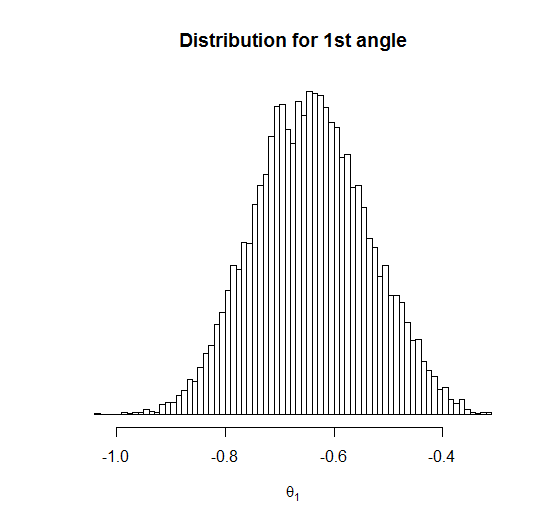I am trying to learn Stan in R and as a fun challenge I am trying to estimate the location of a lighthouse based on the observed flashes. But the models I tried do not converge (Rhat != 1) or have estimated parameters with a large spread.
The observed data are flashes from a lighthouse 100 meters away the (straight) coast line. The angle is uniformly distributed, but the observed flashes along the coast line are heavy tailed.
n_flashes <- 50
loc <- c(0, 100)
angles <- runif(n_flashes, -pi/2, pi/2)
angles_x <- loc[2] * tan(angles)
flashes <- loc[1] + angles_x
I want to estimate the lighthouse location by given the actual model generation process to stan. This is my stan model:
data {
int<lower=0> N;
real flashes[N];
}
parameters {
real x_loc;
real<lower=0> y_loc;
real<lower=-pi()/2, upper=pi()/2> angle[N];
}
model {
x_loc ~ normal(0, 10);
y_loc ~ normal(100, 10);
for (i in 1:N) {
flashes[i] ~ cauchy(x_loc + tan(angle[i]) * y_loc, 1);
}
}
(Note: I model the flash observation with a 1 meter standard deviation, because Stan requires me to give a distribution for flashes[i]).
Then I call the model from R:
n_flashes <- 50
loc <- c(0, 100)
angles <- runif(n_flashes, -pi/2, pi/2)
angles_x <- loc[2] * tan(angles)
flashes <- loc[1] + angles_x
stan_input <- list()
stan_input$flashes <- flashes
stan_input$N <- n_flashes
fit <- stan("lighthouse.stan", data = stan_input)
But this model has large Rhat's. How can I improve this model to prevent this? How can I model the angles in stan? How would you model the location of a lighthouse based on the flashes observed along the coast line?



vector[N] flashes_introduced in the model block, unused in the sence that there are no probability statements related to it. Thus, each component of that vector has an improper $U(-\infty, \infty)$ posterior. Does the issue persist after removing this? $\endgroup$flashes ~ cauchy(x_loc + tan(angle), 1);if you are using the latest (R)Stan. You don't need to loop and you don't need to explicitly doangles ~ uniform(-pi()/2, pi()/2);because that is already implied by the constraints in the parameter declaration. $\endgroup$flashes ~ cauchy(x_loc, y_loc);and this actually gives the perfect result which is a beautiful coincidence :) Still being stubborn here: is there a way to replicate this using a uniform distribution over the angles and then transforming these angles (and locations) to the flash oberservations? $\endgroup$